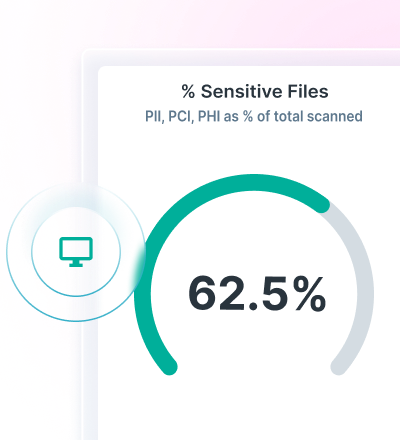The Real-World Impact Of ML Classification: From Concept To Competitive Advantage
0 minutos de leitura

Data has become the most valuable and volatile asset in modern business, and organizations are forced to rethink how they manage it. Traditional classification methods can’t keep up with today’s data velocity or complexity.
Enter machine-learning (ML) classification: the engine behind intelligent data governance. Far from being a laboratory experiment, AI data classification is now a critical component of competitive advantage. It gives enterprises the power to understand their information instantly, apply consistent data classification levels, and act with confidence across compliance, security, and analytics.
What is ML classification, and what makes it important?
In practical terms, ML classification is the automated process of categorizing data based on its content, context, and intent. Algorithms trained on labeled datasets learn to identify patterns: recognizing what constitutes personal information, intellectual property, or public content.
Unlike manual tagging, AI data classification scales infinitely. It can process terabytes of unstructured documents, emails, and images in seconds, applying the appropriate sensitivity or retention level. While that speed is attractive, the real edge is consistency. Every piece of data receives the same objective treatment, regardless of who touches it or where it resides.
For enterprises managing big data classification environments, this consistency is non-negotiable. Regulatory frameworks, from privacy laws to industry standards, demand clear delineation between “public,” “internal,” “confidential,” and “restricted” data. ML automates that enforcement for accurate access control, audit readiness, and risk reduction at scale.
From concept to competitive advantage
When implemented strategically, AI-led classification becomes a foundation for growth. Its impact reaches well beyond automation to redefine how organizations understand and leverage information.
Operational agility
Machine learning removes the manual friction from data governance. Automated labeling adapts to new content formats and languages in real time, reducing classification lag and administrative overhead. More than saving time, this speed accelerates every downstream process because clean, labeled data flows seamlessly across systems.
Risk-aware innovation
Innovation tends to be a function of confidence. With precise, adaptive classification, data teams can explore new models, applications, and integrations without fear of non-compliance. ML systems recognize and quarantine sensitive data automatically, which means development can proceed in controlled environments. Such agility and assurance allows enterprises to launch digital products faster in regulated industries.
Informed decision-making
Accurate classification strengthens data integrity, which is a prerequisite for credible analytics. When every dataset carries context, decision-makers see risk and opportunity clearly. AI data classification can even highlight unseen correlations to help executives anticipate market shifts or internal inefficiencies before they become visible through conventional metrics.
Scalable compliance
Regulations develop constantly, and static rule-based systems can’t keep pace. ML classification scales compliance dynamically, adapting to new data sources and regional requirements without massive retraining cycles. It lets global organizations maintain consistent data classification levels across jurisdictions, reducing audit fatigue and regulatory risk.
Intelligent cost management
By distinguishing between high-value and redundant data, AI data classification optimizes storage, retention, and security investment. Enterprises spend less on protecting irrelevant information while allocating more resources to assets that drive business value.
Building intelligence at scale: The Philippine data opportunity
The Philippines stands at a turning point in its digital evolution. The rapid growth of e-commerce, financial technology, and shared service industries has created an unprecedented surge in data: multilingual, cross-platform, and often unstructured. This explosion presents both opportunity and risk.
Local organizations, from BPO providers to financial institutions, face the twin challenges of scale and compliance. With data privacy governed by the Philippine Data Privacy Act of 2012 (DPA) and increasing scrutiny from both local and offshore clients, data governance can no longer rely on manual control.
Here, AI data classification becomes a force multiplier. Machine-learning models can interpret diverse data sources (from chat transcripts to scanned documents) with speed and accuracy that outpace traditional systems. By automating classification across languages and formats, enterprises maintain compliance and free teams to focus on higher-value analysis and innovation.
As regional integration deepens within ASEAN, Philippine enterprises that invest early in big data classification will gain a competitive edge. Besides reducing risk, properly classified data enhances service delivery and unlocks insights that fuel growth beyond borders.
Implementation essentials: what it takes to make ML classification work
Machine learning transforms classification only when guided by structure and intent. Building that foundation requires governance and alignment across the enterprise. Consider these steps:
1. Define classification with business purpose
Before automating, organizations must link data classification levels directly to business outcomes, not just compliance tiers. “Confidential” should signify potential business impact, instead of just access restriction. This approach gives ML models meaningful context and prevents over-classification, which often slows productivity. Treat labels as strategic markers that determine how information fuels value.
2. Build governance around quality, not quantity
Machine learning learns from what it’s fed. Poorly tagged or outdated data degrades accuracy, while high-quality samples compound precision. Appointing data stewards to continuously review, balance, and retrain models ensures classification reflects the current state of the business.
3. Integrate classification into decision flow
Embedding AI data classification into platforms like DLP or identity management is only the foundation. Maturity begins when classification outcomes directly influence decisions. For instance, high-risk information can trigger automatic legal escalation, while sensitive insights are elevated to executive dashboards for faster response. Integration should make intelligence visible and actionable.
4. Treat accuracy as a living metric
Machine-learning models drift naturally as data evolves. Instead of relying on static benchmarks, enterprises should maintain a live measurement cycle. Monitor false positives, anomaly frequency, and detection speed as indicators of operational fitness. These metrics allow security teams to anticipate degradation before it becomes a risk.
5. Design for resilience
The pace of change in regulation, architecture, and technology means any rigid system will fail by design. Future-ready frameworks use modular architecture and retrainable models, so that new geographies or compliance rules can be introduced without rebuilding the system. Adaptability is a governance necessity.
When these principles converge, ML classification matures from a background process into a continuous intelligence function, one that accelerates growth across every layer of the enterprise.
Data mastery as a business differentiator
In a marketplace defined by limitless data, competitive advantage depends on clarity. Enterprises that can classify, protect, and interpret information in real time outperform those that react slowly.
Forcepoint Data Classification embodies this principle. It applies advanced machine learning to automatically categorize and label information based on content, context, and sensitivity. By integrating seamlessly with enterprise workflows, it gives organizations precise control over how data is used and shared at every endpoint. The result is visibility with intent. Decisions are faster, compliance is proactive, and governance is measurable.
Connect with Forcepoint’s experts to see how AI data classification can turn your data into a sustainable advantage.
No Artigo
X-Labs
Receba insights, análises e notícias em sua caixa de entrada

Ao Ponto
Cibersegurança
Um podcast que cobre as últimas tendências e tópicos no mundo da cibersegurança
Ouça Agora








